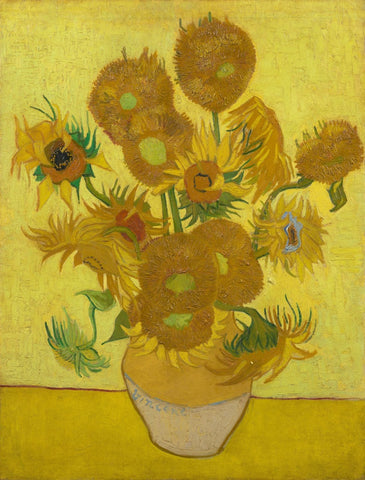The Joy of Sunflowers
Tall, proud and a glorious celebration of the long, lazy, hazy days of summer, it's hard not to smile when you see a sunflower. A true sun seeker, in its youth the young sunflower faces east at dawn and follows the sunlight until it faces west in the evening at sunset, loyal in its adoration of the golden warmth from its rays.
This wonderfully romantic notion is perfectly captured by William Blake:
"Ah Sun-Flower! weary of time,
Who countest the steps of the Sun:
Seeking after that sweet golden clime
Where the travellers journey is done."
Do sunflowers really follow the sun?
Yes! Sunflowers are heliotropic, one of many species that seem to follow or track the sun. The morning eastern light enables the stem to stretch and grow on one side, therefore turning as it does so. In the later western light the same process happens on the opposite side of the shoot, turning the sunflower back around to the east in time for the misty morning light of dawn. This slows as the bloom reaches maturity and you will find the sunflower embraces the morning light most, winding down its westward journeys.
Where does the name Sunflower come from?
The latin name Helianthus Annuus comes from a combination of Greek words. Helios translates to sun and anthos means flower so the literal meaning is flower of the sun.
There are many variations in Greek Mythology on the origin of the sunflower, but all are centred around the Sun God Apollo and the water nymph, Clytie.
A story of unrequited love, Clytie adored Apollo and spent her days gazing skyward in the hope he may look down upon her. But his heart belonged to another and when their love failed to bloom she refused to eat or drink, hanging her head in sorrow.
In time, the Gods felt sorry for her and she was transformed into a sunflower, forever able to follow Apollo's path and her sadness now glowed radiant in happy yellow sunray petals of her own.
Symbolism of sunflowers
This love story is perhaps the reason why sunflowers have become truly symbolic over the years.
The floral emblem for a third anniversary of marriage, their stems symbolise the strong foundation of a relationship while their sunny hues represent the warmth shared in union with another and once more loyalty, through the turning of their heads in adoration of the sun.
Their shape and colour, symbolic of the sun, represents happiness, radiance and all things positive- there never was a more happy and uplifting colour than yellow.
Sunflowers can be quite the good luck charm for those beginning a new path in life, particularly career related. They represent wealth and good fortune. In fact, Incan priestesses in Peru wore garments adorned with large flower shaped ornaments- all of which were made from solid gold.
Other meanings include Focus, Flexibility, Healing, Hope, Enlightenment and Longevity.
Sunflowers in Art
It is easy to see why an artist such as Vincent Van Gogh was so drawn to sunflowers- bright colours, dramatic forms, as well as such obvious symbolism. Really they could represent life itself! He claimed early in his life "the sunflower is mine", realising it was a motif he could make his own.
The bold dark lines of the stems gave sharp contrast against the multi layers of luminous yellows found in the petals. They were a superb source of inspiration for a series of paintings, producing them quickly, with a great energy and confidence so resonant of the sunflower's own vitality for life.
A Joyful Sunflower for-Everley yours...
I think it is fair to say that we all need a little sunshine in our lives. Maybe Joy's beautifully detailed golden sunflower pendant can do just that for you. Wear it alone, or with a little bee or butterfly for a more personal and eclectic look. We have little trowels and gardening forks if yours is a more horticultural interest, we even have an artist's palette for all you budding painters!

"Turn your face to the sun, and shadows follow behind you"
- Maori proverb.
Written By John.
Images Credits:
Sources:
Sunflowerjoy.com
Sunflowerjoy.com
bbc.com
harpers bazaar.com



